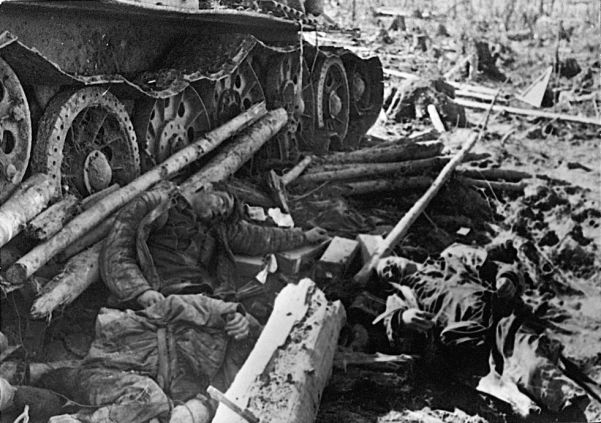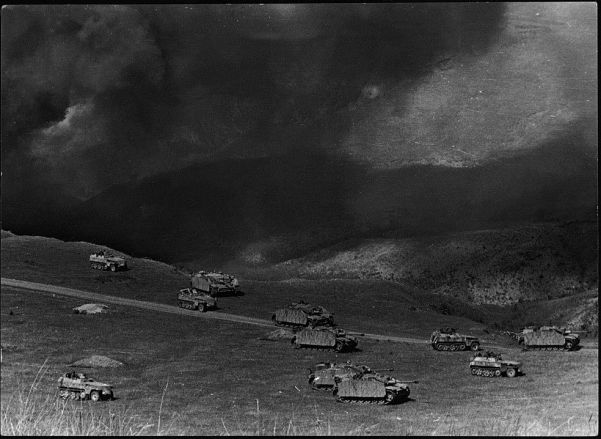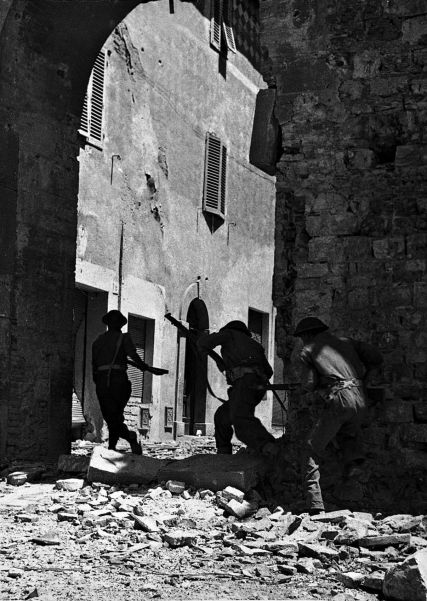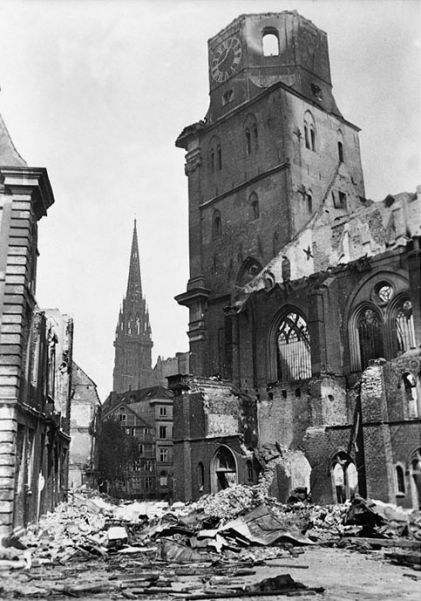5 July
Politics, Poland
General Wladyslaw Raczkiewicz, prime minister of the Polish government-in-exile, is killed in an air crash. His deputy, Stanislaw Mikolajczyk, replaces him.
5-6 July
Pacific, Solomons
The US 43rd Infantry Division leads the main landing on New Georgia. That night US and Japanese destroyers clash at the Battle of Kula Gulf. One Japanese destroyer is sunk.
6 July
Eastern Front, Ukraine

Soviet intelligence has uncovered the plans for the offensive by 900,000 German troops against Kursk. The Germans believe that a victory on the Eastern Front will bolster domestic morale and preserve the Axis coalition, while also demonstrating to the Allies that the Nazis can still achieve victory. From March to July, they gather 900,000 troops but the Red Army succeeds in establishing numerical superiority in men (1.3 million) and equipment.Consequently, German units are exposed to aerial and land bombardment while the Red Army prepares for the attack. The German Army Group Center’s Ninth Army, south of Orel, and Field Marshal Erich von Manstein’s Fourth Panzer Army, north of Kharkov, open Operation Citadel with an offensive against the salient. The Ninth Army under Field Marshal Gunther von Kluge only penetrates six miles (9 km) and loses 250,000 men. Over 6000 German and Soviet tanks and assault guns take part in the war’s greatest armored battle. Special attention is given by the Soviets to antitank guns and obstacles. The Germans deploy 200 aircraft for the operation and the Soviets 2400.
6-9 July
Eastern Front, Ukraine

Increasing numbers of German troops reinforce the Kursk offensive but the Red Army stands firm. The Soviets counter the Germans with a deep defensive network while heavily-armed antitank units deliver concentrated fire against German armor. The Soviets quickly gain air superiority and fighters provide valuable tactical support. These measures combine to prevent the German attacks penetrating the Soviet defenses.
7-13 July
Pacific, Papua New Guinea
The Japanese strongpoint at Mumbo, 10 miles (16 km) inland from Salamaua, is seized by the Australians. US and Australian forces are battling to dislodge the Japanese from the high ground they have retreated to. Allied reinforcements are to be landed in order to clear the Japanese from northeast New Guinea.
9 July
Mediterranean, Sicily
Chaotic US and British airborne landings begin the attack on Sicily. Preparatory bomber attacks have already hit air bases on Sicily, Sardinia, and on the mainland. Mussolini expects the Allied attack to be against Sardinia. The main strategic objectives are to clear the Mediterranean sea-lanes, divert Axis forces from the Eastern Front, and possibly apply pressure on Italy to accelerate its capitulation.
10 July
Mediterranean, Sicily
An invasion fleet of 2500 vessels carries General Bernard Montgomery’s Eighth Army and General George Patton’s Seventh Army to southern Sicily. The Italians are surprised as they did not expect an attack during stormy weather. The Allies will eventually land 160,000 men to fight General Guzzoni’s Sixth Army (230,000 Italian and 40,000 German troops). Landings are assisted by a new amphibious truck - the DUKW.
11-12 July
Mediterranean, Sicily
The German Hermann Goering Panzer Division almost reaches US forces on the coast near Gela and Licata but the counterattack is obstructed by US paratroopers. General Sir Harold Alexander, overall commander of the operation, expects the Eighth Army to advance up the east coast toward the key bases at Catania and Messina. The less experienced Seventh Army is to protect the British flank and rear.
12-13 July
Eastern Front, Ukraine
At Kursk, the Soviets launch a counter-offensive around Prokhorovka and an enormous tank battle develops. Field Marshal von Manstein’s Fourth Panzer Army advances 25 miles (40 km) but loses 10,000 men and 350 tanks. Farther north, the Soviet Bryansk and West Fronts begin an offensive around Orel. Adolf Hitler calls off Operation Citadel on the 13th. The last major German offensive on the Eastern Front has been a costly failure with the loss of over 550 tanks and 500,000 men killed, wounded, or missing. It is a major disaster for Germany, not least because the carefully-gathered strategic armored reserves have been wiped out in the fighting.
Sea War, Pacific
At the Battle of Kolombangara, off New Georgia, a Japanese squadron led by Admiral Izaki engages three US light cruisers and 10 destroyers. One US destroyer is sunk and one New Zealand and two US cruisers are damaged. The Japanese lose a cruiser.
15-23 July
Mediterranean, Sicily

The US Seventh Army advances westward aiming to seize the capital Palermo with an armored thrust.
17 July
Eastern Front, Ukraine
The Soviet Voronezh Front, just to the south of Kursk, and the Steppe Front, to the west of Kharkov, begin pursuing the German forces, which are now retreating in some confusion.
17-18 July
Mediterranean, Sicily
The British Eighth Army strikes northward toward the Axis stronghold at Catania but meets determined resistance from the Hermann Goering Division on the plain beneath Mount Etna. The British therefore decide to go around Catania toward Mount Etna, while the US Seventh Army moves along the north coast toward Messina.
19 July
Politics, Axis
Benito Mussolini and Adolf Hitler meet at Fletre in northern Italy. The Italian dictator fails to tell Hitler that his country is to cease fighting and instead endorses the proposal for Germany to assume military control in Italy. The first major Allied air raid is made on the Italian capital, Rome, by US bombers on the same day.
23 July
Mediterranean, Sicily
The US Seventh Army enters Palermo and the west coast ports of Trapani and Marsala.
23-24 July
Eastern Front, Ukraine
The German armies have now withdrawn to the lines held at the start of Operation Citadel at Kursk.
23-30 July
Mediterranean, Sicily
The Allies drive to Messina while German forces try to save the Sicilian bridgehead and the airfields around Catania. US forces move along the north coast and Highway 120 inland.
24 July
Politics, Italy
The Fascist Grand Council, the key constitutional body for debating government and party decisions, meets for the first time since 1939. Dino Grandi, former minister of justice, proposes that military authority should be given to the king and not Mussolini. His motion is approved.
24 July - 2 August
Air War, Germany

A series of massive British raids are made on Hamburg. The attacks are made over four nights and last until August 2. The dropping of foil strips to confuse German radar equipment (the ‘Window’; system) helps the bombers. Around 50,000 people are killed and 800,000 are made homeless. The attack on the 27th-28th creates a firestorm, which blazes so intensely that the flames suck oxygen from the area nearby. This creates a ‘hurricane’; effect that feeds the flames, which travel at great speed.
25 July
Politics, Italy
The king of Italy relieves Benito Mussolini of his office. Mussolini is arrested and Marshal Pietro Badoglio forms a new government that lasts only six weeks. The government deters Germany from occupying the entire country by promising to fight on. Badoglio hopes, however, that the Allies will land and occupy most of Italy quickly and therefore confine any fighting to the north.
26 July
Eastern Front, Ukraine
The German high command orders forces around Orel to withdraw to the previously-prepared Hagen Line, just to the east of Bryansk.
